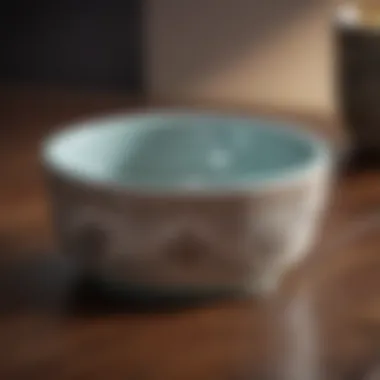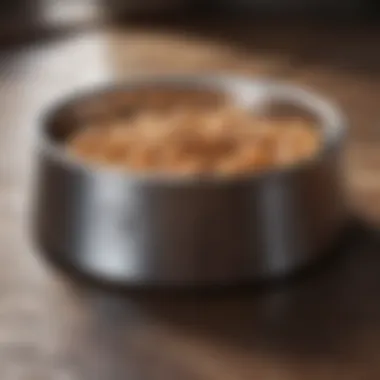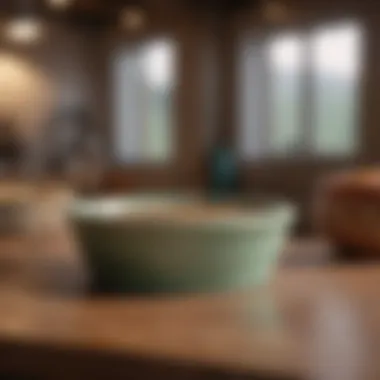Best Made Dog Bowl: Features, Materials & Design Insights


Intro
When selecting the best dog bowl, it's crucial to consider various factors, including material, design, and size. A well-made dog bowl not only enhances the dining experience of your pet but can also significantly impact their health. With numerous options on the market, how do you discern which bowl is suitable for your furry friend? This article delves into the characteristics, materials, and design aspects that distinguish top-quality dog bowls. We will also examine their functionality, durability, and maintenance requirements, empowering you to make informed choices for the well-being of your dog.
Fascinating Facts About the Animal
Dogs have been domesticated companions for thousands of years, showcasing unique characteristics that endear them to families worldwide. Their ability to form strong bonds with humans and understand commands is remarkable.
- Unique Characteristics
Dogs are known for their superior sense of smell, which is over 40 times more sensitive than humans. They also possess acute hearing and can detect sounds at frequencies much higher than what humans can perceive. These traits contribute to their roles as service animals and companions in various fields. - Extraordinary Abilities
The cognitive capacity of dogs is fascinating. They can learn hundreds of words and phrases, displaying an understanding of complex commands. This open communication leads to a more harmonious relationship with their owners. Furthermore, certain breeds possess specialization abilities, such as herding, hunting, and guarding.
Behavior and Habitat
Understanding dog behavior and habitat requirements is essential for effective care.
- Natural Habitats
While dogs are primarily indoor pets today, their ancestry lies with wolves that thrive in forests and plains. Successful dog bowls should reflect these natural instincts by accommodating eating patterns conducive to their species-wide behavior. - Social Structures
Dogs are inherently social animals, often exhibiting pack behavior. This social structure influences their eating habits; for example, some dogs may prefer to eat in a quiet environment away from distractions, while others are more comfortable sharing their space with other pets.
Recent Scientific Discoveries
Recent research into canine biology has unearthed valuable insights that enhance our understanding of dog nutrition and behavior.
- Latest Research Findings
Studies reveal that diet plays a crucial role in the overall health of dogs. A raised dog bowl, for example, may improve posture and reduce strain on joints in larger breeds. - Breakthroughs in Animal Biology
Genetic research has indicated specific breed predispositions to certain health conditions. This information may guide owners in selecting dog bowls designed for their pet's specific needs, such as elevated bowls for larger breeds.
Cultural Significance
Dogs have deeply influenced culture, art, and society, reflecting their importance across history.
- Animals in Folklore
Various cultures have revered dogs, featuring them as symbols of loyalty and protection in mythology and folklore. - Influence on Art and Literature
Artists and writers often depict dogs as a source of companionship or reflection of virtues like loyalty and courage, shaping perceptions and cultural beliefs about them.
Understanding a dog's behavior and needs is fundamental in choosing the right bowl, ensuring health, comfort, and enjoyment during feeding times.
Understanding Dog Bowls
Understanding dog bowls is a crucial aspect for any pet owner, as it influences not only the dining experience of the dog but also their overall health and well-being. Certain factors like material, size, and design come into play when selecting the most suitable bowl for a canine companion. A thorough comprehension of these elements can help pet owners make informed choices when purchasing a dog bowl. This analysis highlights the significance of selecting appropriate dog bowls based on various considerations.
Purpose of Dog Bowls
Dog bowls serve as the primary vessels for feeding and watering pets. Their purpose extends beyond mere functionality; the right dog bowl can positively impact a dog's eating habits and hydration levels. An appropriate bowl helps to maintain the health of a pet by encouraging regular, organized feeding.


Properly designed dog bowls can minimize mess, while also catering to specific breeds and their unique needs. For instance, a deep bowl might be beneficial for a Greyhound, while a shallow bowl would suit a smaller breed. Moreover, hygiene is essential, and good quality bowls can help reduce the risk of bacterial growth and other health issues.
Key Factors of Purpose
- Animal Health: The right bowl promotes healthy eating habits.
- Convenience: A well-designed bowl facilitates easy feeding and cleanup.
- Comfort: Size and design affect how comfortably a dog can eat.
Historical Perspective
The evolution of dog bowls mirrors the development of human-animal relationships. Historically, dogs fed from communal troughs or available scraps without designated bowls. The concept of a dedicated dog bowl emerged as the understanding of canine nutrition and welfare improved.
In earlier times, metal or ceramic containers were used, but modern advancements in materials have introduced various options. Today, bowls made from stainless steel, plastic, or ceramic provide a range of functionalities and styles. This progression illustrates a growing awareness of dogs as companions deserving of specialized care and attention.
Timeline of Dog Bowl Evolution
- Pre-Historic: Use of natural resources for feeding.
- Middle Ages: Formation of basic feeding vessels.
- 19th Century: Increased focus on pet welfare leading to the creation of specialized bowls.
- Modern Era: Diverse materials and designs; a myriad of options for all breeds.
Types of Dog Bowls
Understanding the various types of dog bowls is essential when selecting the best option for your pet. Each type comes with distinct materials and designs, leading to unique benefits and considerations. Knowing these nuances can significantly impact the functionality and enjoyment of your dog's feeding experience, ensuring that it meets their specific needs.
Ceramic Dog Bowls
Ceramic dog bowls are often favored for their aesthetic appeal. They come in a variety of colors and designs, making them visually pleasing in any setting. However, it's crucial to ensure that they are made from non-toxic glazes. They are generally heavier than plastic options, which can minimize movement during feeding. Also, ceramic bowls are less likely to harbor bacteria due to their smooth surfaces. Nevertheless, they can chip or crack if dropped, which requires careful handling.
Stainless Steel Dog Bowls
Stainless steel bowls are known for their durability and resistance to rust. They are also non-reactive, which means they won't change the taste of your dog's food. These bowls are easy to clean and often dishwasher safe, making maintenance simple. One significant benefit is that they do not retain odors, unlike some plastic bowls. On the downside, some dogs may find metal less appealing due to temperature fluctuations. It's important to choose high-quality stainless steel to avoid issues with finishes that can wear off over time.
Plastic Dog Bowls
Plastic dog bowls are lightweight and affordable, which makes them a popular choice among pet owners. They come in various sizes and shapes, accommodating different dog breeds. However, they may not be as durable as other materials, and some cheaper variants can harbor scratches that may trap bacteria. Additionally, plastic can become discolored and retain odors over time. Opting for higher-grade plastic can mitigate some of these issues, as well as ensuring BPA-free options to safeguard pet health.
Collapsible Dog Bowls
For pet owners who are often on the go, collapsible dog bowls are an excellent solution. These bowls can easily fit into backpacks, making them great for travel, hiking, or outings. They are usually made from silicone or soft plastic, which allows them to be folded flat. While they are convenient, it's vital to ensure that they are sturdy enough to withstand your dog's enthusiasm when eating. Keep in mind that they should also be easy to clean, as portability may lead to increased exposure to dirt and bacteria.
Elevated Dog Bowls
Elevated dog bowls can provide several advantages, especially for larger breeds or older dogs. By raising the bowl to a more comfortable height, these bowls help reduce strain on the dog's neck and joints. Many elevated designs also incorporate storage for food or water underneath, promoting organization. However, not all dogs require elevated bowls, and it is essential to assess your pet's individual needs before making a decision. The quality of material used in the construction of elevated bowls varies, so consider a sturdy design that can withstand any enthusiastic feeding.


Key Features to Consider
Choosing the right dog bowl goes beyond aesthetics. Key features define functionality and ensure the well-being of your pet. Understanding these facets helps pet owners make informed decisions tailored to their dog's needs.
Material Quality
Material quality is foundational when selecting a dog bowl. For instance, different materials offer varying benefits and drawbacks. Ceramic bowls are popular due to their attractive designs and weight. However, they may chip and be difficult to maintain if dropped. Stainless steel stands out for durability. It does not harbor bacteria and often comes with a non-slip base. Plastic bowls, while lightweight and affordable, can leach harmful chemicals if not specifically labeled as non-toxic. Pet owners should inspect labels closely. Opting for non-toxic materials ensures they are safe for your dog, promoting overall health.
Materials should also support ease of cleaning. Some bowls are dishwasher safe, making maintenance simpler. Investing in high-quality materials leads to better longevity, therefore saving costs in the long run.
Size and Capacity
Size and capacity play crucial roles in the functionality of dog bowls. Choosing the right size depends on your dog's breed, age, and eating habits. For small breeds like Chihuahuas, a smaller bowl is sufficient, while large breeds such as Great Danes need larger, deeper bowls. A bowl that’s too small can lead to spills, while one that is excessively large can make it difficult for dogs to access food.
In terms of capacity, measuring your dog's food intake is essential. Many bowls come with specific measurements. This helps in managing portion sizes. A bowl that is too large may result in overeating, leading to health issues like obesity. Always opt for bowls that fit your pet's needs, ensuring an optimal dining experience.
Anti-Slip Design
An anti-slip design is a critical feature for many dog owners. Dogs can be enthusiastic eaters, causing bowls to slide around during mealtimes. Bowls with rubberized or weighted bases can reduce this movement significantly. This feature prevents spills and makes feeding time less messy.
Moreover, a stable bowl encourages dogs to maintain their posture while eating. Good posture contributes to more comfortable digestion, especially in larger breeds. Dogs that feel secure while eating are less likely to experience anxiety, leading to a more relaxed feeding environment. Therefore, when selecting a bowl, consider those designed to stay in place.
Weight Variations
Weight variations of dog bowls can influence their performance. Heavier bowls are less likely to tip over during vigorous feeding, which is a distinct advantage. A bowl that remains in place during meals allows for better focus on eating and drinking. However, not every dog owner prefers heavy bowls. Portable bowls, for instance, are favored for travel. Lightweight options are more comfortable to carry but may need anti-slip features to ensure stability.
Consider the lifestyle of both you and your pet. If you travel often, a lightweight option may suit you better. Using a heavier bowl at home can provide stability and support for larger breeds. The right weight should match your dog's feeding habits and your living situation, providing the best experience for both.
The proper features in a dog bowl directly impact the health and convenience of feeding practices. By focusing on material quality, size, anti-slip design, and weight variations, one can enhance the dining experience for dogs significantly.
Health and Safety Considerations
When it comes to selecting the right dog bowl, health and safety are paramount. The materials used, the ease of maintenance, and the design of the bowl can all affect your dog's overall well-being. Ensuring that the dog bowl is safe is more than just a matter of convenience; it contributes significantly to your pet’s health and comfort.
Non-Toxic Materials
Choosing a dog bowl made from non-toxic materials is critical. Many bowls are made with harmful chemicals that can lead to health issues. Common materials include ceramic, stainless steel, and certain plastics. Always look for products labeled as BPA-free or free of phthalates. These labels ensure that no toxic substances will leach into your dog's food or water. Using safe materials not only protects your dog but also gives peace of mind to owners.
Bacteria and Odor Resistance


A dog bowl must resist the growth of bacteria and odors. Some materials, like stainless steel, have excellent antibacterial properties. They are less porous than ceramics or plastics, reducing the chances for bacteria to linger. Furthermore, ceramic bowls can also be coated with a glaze that inhibits bacterial growth. It is vital to consistently clean and maintain the bowl to ensure a healthy dining environment for your dog. A clean bowl prevents potential health risks, such as infections or digestive issues.
Ease of Cleaning
The ease of cleaning a dog bowl cannot be overstated. Bowls should be dishwasher safe or easy to wash by hand. Investing in bowls that do not retain stains or odors can simplify maintenance. A bowl that can be easily sanitized will help eliminate bacteria and food remnants that can potentially harm your pet. Regular cleaning should be prioritized as part of your dog care routine. A clean bowl equates to a healthy eating environment, and this aspect should not be overlooked.
Prioritizing the health and safety implications of dog bowl selection can lead to better pet health outcomes.
In summary, understanding the health and safety considerations will inform your choices. Selecting non-toxic materials, ensuring bacteria and odor resistance, and prioritizing ease of cleaning are vital steps. By doing these, you not only enhance the dining experience for your dog but also safeguard their health.
Cost vs.
Quality
In the selection of dog bowls, understanding the relationship between cost and quality is paramount. Each dog bowl on the market comes with its own price tag, often influenced by materials, design, brand, and features. However, higher price does not always guarantee superior quality. A thoughtful contrast between cost and quality leads to informed choices that benefit both the pet and the owner.
Evaluating Price Points
When evaluating price points, several factors come into play. First, consider the material of the bowl. For example, stainless steel bowls often cost more than plastic alternatives but tend to offer superior durability and safety. Additionally, bowls made from non-toxic materials may command a higher price but ensure the health of your pet.
Factors that influence price include:
- Brand reputation: Well-known brands like PetFusion and Outward Hound may charge more.
- Design details: Ergonomic designs or customizable options might add to costs.
- Functionality: Features like anti-slip bases or elevated designs for larger breeds typically increase the price.
Ultimately, it is essential to weigh the importance of these features against your budget and your dog’s needs.
Return on Investment in Pet Health
Investing in a quality dog bowl can have long-term benefits. A well-made bowl could reduce health issues associated with feeding, such as digestive problems or infections. Additionally, a durable bowl may require less frequent replacements, allowing for better cost efficiency over time.
Key points in considering return on investment include:
- Durability of materials shows promise for longevity, saving you money in the long run.
- Health Features like bacteria resistance or ease of cleaning lead to better hygiene.
- Comfortable Eating Experience: Elevated or specially designed bowls promote better digestion for certain breeds.
Culmination
The conclusion is a crucial element in any comprehensive analysis, serving as a capstone to the findings presented earlier. In this article, it synthesizes the key insights regarding dog bowls, emphasizing their multifaceted roles not only in feeding but also in ensuring the well-being of pets.
Recap of Essential Points
A brief overview of the main points discussed will help distill the vast information into takeaways that are easy to remember. The various types of dog bowls—ceramic, stainless steel, plastic, collapsible, and elevated—have distinct benefits and are suitable for different circumstances. Material quality, size, capacity, and anti-slip design remain vital features to consider during selection. Health and safety considerations like non-toxic materials, resistance to bacteria, and ease of cleaning further emphasize the importance of choosing wisely. Finally, understanding the balance between cost and quality allows dog owners to make educated decisions that align with their budget and their pet's needs.
Final Thoughts on Dog Bowl Selection
Ultimately, the selection of a dog bowl encompasses more than mere aesthetics. It is about enhancing a pet's dining experience while also safeguarding their health. Pet owners should be mindful of the individual needs of their dogs, considering factors that go beyond basic functionality. Investing in a quality dog bowl can yield long-term benefits for both the pet and the owner. There is a broad spectrum of options available in the market today, yet narrowing it down to a few well-informed choices requires diligence and thorough understanding. By prioritizing the needs of the pet and using the insights gained, one can confidently make the best selection for their furry companions.







